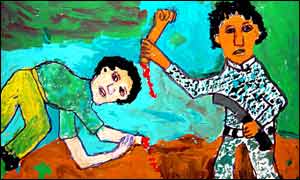
But in Sierra Leone, a country where the people have learnt the hard way that anything is possible, that is exactly what you will find.
I feel so happy now. With my paintings I’ve been able to show people why I am like I am.
|
|
Seih Mansaray
|
An afternoon visit to Aberdeen amputee camp satisfied my curiosity.
In a rundown shack at the back of this makeshift village, I found the artists hard at work.
One’s immediate impression is of how colourful this small, dusky room is.
Colourful, not only in comparison with the dirty brown of the surrounding camp, but colourful because of the smiles.
Not all the artists are amputees – many of them are children of amputees.
Light into their lives
But all of them are victims of war.
During Sierra Leone’s 10-year civil war, thousands of innocent civilians had their limbs hacked off.
The rebels of the Revolutionary United Front (RUF) were the main perpetrators, but many of those maimed by machetes will accuse government soldiers.
|
Amputees have found a new goal in painting
|
Between fighting forces it was, the amputees say, like for like.
But the end result is the same.
There is an overwhelming feeling of depression in the camp.
On previous visits numerous amputees had told me that they would rather be dead.
‘What use am I now?’ they ask in frustration, waving a severed limb as if to illustrate the point.
Focus
‘How can I help my children grow up and have a decent life?”
Finally a very simple project has brought some light into their lives.
Some of the children, as well as their disabled parents, have found something to focus on.
|
The project is about taking and giving
|
The painting is both therapeutic and potentially lucrative.
It all started out of guilt.
‘Guilt’, because some United Nations staff who had been carrying out research with the amputees felt that it was all take and no give.
They were looking for a way to give something back to the amputees.
Then Hillary Ravenscroft arrived in Sierra Leone, joining her husband on a business trip.
Healing process
As a teacher and an artist she was able to take up the mantle for the frustrated UN staff, and started the art project.
Its impact, she says, has been remarkable.
The act of recreating their memories as a shared image has become part of a healing process for the amputees.
|
Seih Mansaray says painting has changed his life
|
But Hillary would not accept the credit for such therapy.
This has become a community project at heart.
Local businesses provide bits of material for the artists; a ream of paper from a print shop, a bucket of paint from a paint manufacturer.
What is more, the volume of work that the artists has produced illustrates the dedication with which they have thrown themselves into the project.
Godsend
In less than three months more than 500 pieces of art have materialised, and the art group, of more than 50 people, keeps on growing.
Seih Mansaray is the oldest amputee in the group.
He no longer cries at night. Instead he puts his worries and dreams into his art.
|
|
Hillary Ravenscroft
|
For him painting has been a godsend, a way of telling his story and exorcising the demons that have plagued his mind since rebels hacked off his right arm four years ago.
“I feel so happy now. With my paintings I’ve been able to show people why I am like I am,” he says.
His pictures are basic but their content is brutal.
A smiling rebel stands over him holding an arm aloft as a trophy.
“They laughed at me,” he says. “But I’ve got a life again, I can do something useful. When I paint I forget that I’ve only got one arm.”
New lease of life
One of the children in the camp, Abu Bangura, lost his father to the rebels.
His mother had both her legs cut off.
|
Abu Bangura will buy food with the painting money
|
As the oldest child, Abu assumed responsibility for the family.
The burden was often too much to bear but, as Hillary explains, the painting has given him a new lease of life.
“He no longer cries at night. Instead he puts his worries and dreams into his art,” she says.
The therapeutic aspect of the painting is undeniable but recently another, more concrete benefit has been added.
Art for food
The amputee art is being sold.
An exhibition at the UN headquarters in Freetown sold almost every piece of work.
Standing in front of his gallery of paintings Abu’s eyes light up.
Every item has a “Sold” sticker on it.
“I am so proud, I’ve sold everything. Now I will be able to buy enough food for my family and maybe even continue my education,” he says.
|
Amputees learn to come to terms with their disability
|
This monetary aspect is integral to the project.
The amputees and their families are desperately short of money.
This little project has made a significant difference to so many lives.
Some might argue that their work is only popular because of who they are.
Their customers are more interested in the fact that the painting they buy is from an amputee camp.
For many the aesthetic value of the painting is secondary, but so what?
More and more foreigners are coming to Sierra Leone, and the macabre fascination with amputees is always there.
The amputees and their family have found a way of making money out of this western curiosity about brutality.
More importantly, however, they have found a way to deal with the terrible memories they have bottled up inside.
BBC News Tuesday, 11 June, 2002, http://news.bbc.co.uk/1/hi/world/africa/2038949.stm






